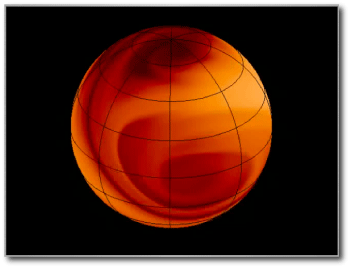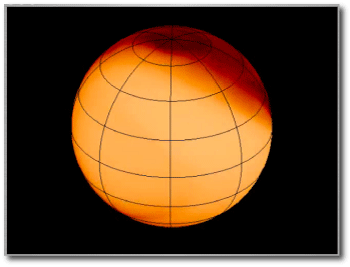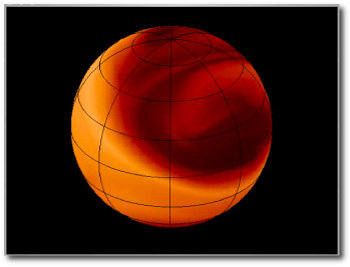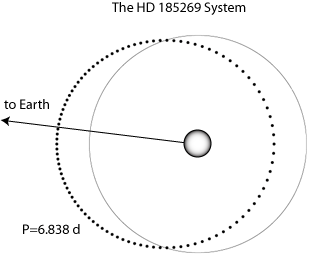
Image Source.
From all accounts, it looks like Jonathan Langton’s talk at last week’s AAS meeting in Honolulu went quite well. Here’s a link to a gzipped tar file of his Keynote presentation. It weighs in at 10.5 MB, and includes a number of cool animations. The following frames have been grabbed from the 2-orbit animation of HD 185269b:



We’re putting the finishing touches on a paper that we hope to submit this weekend. It shows that there’s a remarkable range in weather patterns and predicted infrared light curves among the short-period planets with non-zero eccentricity. The bottom line is that HAT-P-2b and HD 80606b are the best prospects for Spitzer observations, whereas HD 185269 b seems to produce the most complex and photogenic weather (see the three frames above).

HD 185269 b was discovered by John Johnson during the course of his radial velocity survey of slightly evolved high-mass stars. The orbital eccentricity is a modest yet still significant e=0.3, which leads to a 344% increase in the amount of energy received by the planet between apastron and periastron. This seasonal variation is strong, but not crazy enough to drive the shock waves that show up on HD 80606 b or HAT -P-2b. The combination of Coriolis deflection, periodic heating, eddy formation and Kelvin-Helmholtz instabilities on a global scale lead to a mesmerizing, endlessly evolving flow.

Hi Greg,
I know you’re very busy so I will give you a friendly reminder. Is SOFIA going to be used in these atmospheric analyses?
Also, I got an email from the head of ESA about the launch of the Herschel IR probe. What role is that going to play, if any, in our investigations?
Best,
Eric
P.S.
One of my many minors as an undergraduate was geology. One of the things that we studied in great detail was the Coriolis effect on Earth. I am very intrigue by the details which will emerge regarding the Coriolis deflection of HD 80606 and Hat-P-2b.
Shock waves, as far as gas-giants, is similar to star-quakes if the temperature within the core is sufficent to cause a boiling effect on the surface that is strong enough to induce a sufficient sound wave on the surface. These are the requisite conditions for causing a star-quake or in the most extreme conditions a stellar Tsunamis.
If the core of a short-period hot gas-giant were heated enough during periastron, I would imagine that it would follow the thermo-dynamics of a hot plasma, i.e., a star.
The equatorial part of the gas-giant would move faster than the parts closest to the poles and even more so during periastron. Thus by a deferential rotation, assuming the gas-giant has a metal core, i.e. hydrogen which is hot and rotating faster relative to the to the mean rotation of the gas-giant, then like a star it would induce an electro-magnetic field which over respective periods could vary from unipolar to giga-polar over the life span of the gas-giant. This fluctuation of polarity could account for the difference of kinetic energy of the gas-giant that would cause the seasonal variation.
It’s just my hypothesis (i.e. I writing out loud) but that’s what first comes to mind.
Best,
Eric
Despite everything that I have said above, I think I failed to make my point.
I guess what I’m trying to say is that with these hot-Jovian planets, because of their short periods and because of their proximity to their respective stars at periastron, their atmospheres behave more like stars than the gas-giants that we’re so dogmatically accustomed to such as Jupiter. They boil at the surface, thus producing tremendous sound waves within the plasma, thus generating unimaginable heat they same way that the chromosphere heats up the corona of our sun. This is what I believe accounts for the climate and various phenomena such is planet quakes (i.e. ripples on the surface, like those caused by a pebble thrown upon the still waters of a pond.)
This is a whole new level of the laws of thermo-dynamics, quantum mechanics and perturbation theory. These kinds of planets are redefining our understanding of planetary science and physics at the most basic level.
Best,
Eric
Hi Eric,
I don’t know very much about Sofia. I think that it has a high-resolution spectrograph, but that it’ll be difficult to get the S/N to really dig interesting information out about the transiting extrasolar planets.
Anyone in the know?
best,
Greg
That’s OK, Greg. I was just curious. Thanks anyway.
Best,
Eric
Pingback: systemic - Vorticity